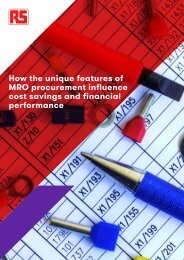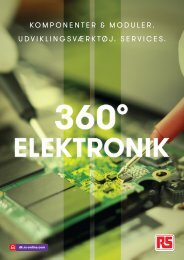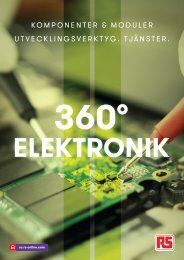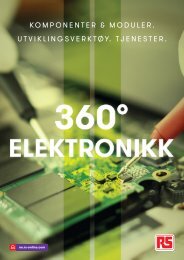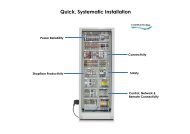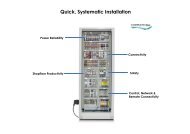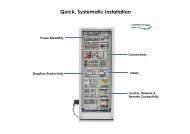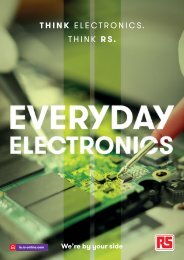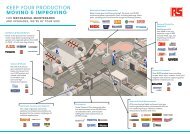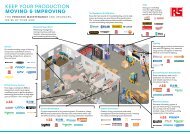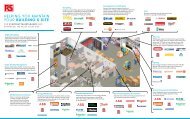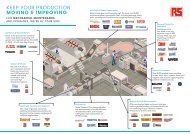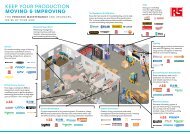Electronic Solutions SG
Create successful ePaper yourself
Turn your PDF publications into a flip-book with our unique Google optimized e-Paper software.
adoption around the globe, and Industry<br />
4.0 and the industrial application of the<br />
internet of things (IIoT) are well-suited.<br />
Two of the founding principles of Industry<br />
4.0 are interconnection and information<br />
transparency. The IIoT is at the very heart of<br />
interconnection. The basic premise behind<br />
interconnection is to<br />
be able to digitally<br />
link manufacturing<br />
and production<br />
assets together<br />
via monitoring,<br />
control and analysis<br />
applications. The<br />
interconnection meant<br />
that any item of<br />
industrial automation<br />
or process equipment<br />
could provide data<br />
in real-time about its<br />
operational status<br />
and performance.<br />
Interconnection<br />
is also a two-way<br />
communication,<br />
allowing control<br />
of machinery and<br />
plant automatically<br />
or through human<br />
intervention.<br />
The collection of<br />
data across a<br />
whole production facility creates masses<br />
of data points, which when aggregated<br />
would yield the critical manufacturing<br />
management metrics of operational<br />
efficiency (OE) and overall equipment<br />
effectiveness (OEE) with ease.<br />
Keeping any factory or production process<br />
running, with high levels of efficiency and<br />
effectiveness depends on reliable machinery.<br />
Unfortunately, anything mechanical tends<br />
to have parts that wear or fail over time. For<br />
a linear production process, the failure of<br />
one item of machinery can stop the whole<br />
factory, so over the years formal maintain,<br />
repair, and operate (MRO) regimes have<br />
become necessary to ensure production<br />
equipment keeps running. Thanks to<br />
the IIoT, implementation of a preventive<br />
maintenance routine is possible that<br />
gives plant management early warning to<br />
potential equipment failures and to be able<br />
to schedule maintenance intervention for<br />
when it is operationally most effective.<br />
Acquisition of the critical data required for<br />
both operational and maintenance purposes<br />
comes from sensors deployed on production<br />
assets. This is where the semiconductor<br />
manufacturers come into force, the sensor<br />
development they have undertaken can be<br />
used to detect the common key indicators<br />
of performance levels through signature<br />
analysis. Sensors can detect vibration,<br />
temperature, humidity, sound and a<br />
whole host of other environmental factors.<br />
Many of these can be used to determine<br />
the operation life of assets, but more<br />
importantly flag any issues that arise before<br />
unexpected costly breakdown occurs.<br />
Also, inspection sensors such as camera<br />
sensors function as inputs to image<br />
recognition systems that check, for example,<br />
if a brand label affixed to a bottle does not<br />
conform to correct placement tolerances.<br />
STMicroelectronics is helping customers<br />
to evaluate predictive maintenance<br />
implementation with the release of their<br />
STWIN prototyping evaluation board for<br />
IIoT applications (RS Stock No. 193-9794).<br />
This ultimately allows the user to deliver<br />
the benefits of condition monitoring<br />
on key critical industrial assets.<br />
STWIN from STMicroelectronics<br />
There is a wide range of different sensor<br />
technologies in use today, from simple<br />
discrete thermistors to detect temperature,<br />
to complex micro-electromechanical (MEMS)<br />
sensors used to detect acceleration forces.<br />
The vast majority of sensor outputs today<br />
are processed into the digital domain<br />
within the sensor and then transmitted<br />
across wired or wireless networks to the<br />
host control and monitoring system.<br />
Technology innovations<br />
will drive Industry 5.0<br />
Before many manufacturing organisations<br />
have even completed their Industry 4.0<br />
deployments, the industry has started<br />
talking about Industry 5.0. Industry 5.0<br />
offers the potential to bring the human<br />
back into the manufacturing loop, a<br />
notable omission in Industry 4.0.<br />
Implementing Industry 4.0 hasn't been<br />
without its challenges. Factory floor space<br />
is at a premium across the world, so many<br />
manufacturing operations found themselves<br />
having to squeeze more and more electronicsbased<br />
systems into existing control cabinets.<br />
In most cases, these were already nearly<br />
full, so packing more tech into a spaceconstrained<br />
cabinet required more innovation.<br />
Established industrial automation equipment<br />
manufacturers needed to make their PLCs<br />
and control cards more functionally dense,<br />
more power-efficient, and slimmer. Thankfully,<br />
the semiconductor industry provided the<br />
answers with innovations that offered<br />
higher levels of functional integration; for<br />
example, a four-channel analogue-to-digital<br />
converter (ADC) complete with a low noise<br />
isolated DC/DC converter compared to a<br />
previous single-channel ADC. Intelligent<br />
power management ICs, and driving higher<br />
power conversion efficiencies by using widebandgap<br />
process technologies, reduce the<br />
amount of waste heat requiring dissipation,<br />
further reducing overall system size.<br />
For Industry 5.0, innovations from the<br />
semiconductor industry will continue to be<br />
in demand. One aspect of Industry 5.0 is<br />
that for some processes, robots will work<br />
alongside skilled human counterparts. There<br />
has been a lot of research into the use of<br />
collaborative robots and how they need<br />
to interact with humans nearby. Safety<br />
barriers usually surround industrial robots to<br />
prevent accidents; however, to be productive<br />
cobots will need to work beside humans,<br />
introducing more sensing requirements.<br />
Another lesson learnt from Industry 4.0<br />
and its use of IIoT centres around the<br />
amount of data transmitted, latency, and<br />
cloud-compute capabilities. Many sensors<br />
do not include any control element; they<br />
send data to the production management<br />
system at a set frequency. Aggregated<br />
together with hundreds and potentially<br />
thousands of sensors in a single site, this<br />
can represent a significant data bandwidth<br />
requirement. Also, the communications<br />
node-cloud-control latency involved in<br />
receiving sensor data to taking action can<br />
be substantial, removing the possibility of<br />
cloud-based control for some tasks. New<br />
types of sensors need to not only sense but<br />
also infer a control action. Likewise, local<br />
gateway aggregators could have a degree of<br />
devolved autonomy passed to them to control<br />
specific tasks within predefined bounds.<br />
The semiconductor industry is responding<br />
with low power microcontrollers that include<br />
sensing elements and enough compute<br />
resource to run task-specific artificial<br />
intelligence algorithms. These devices<br />
contain a computer hardware architecture<br />
optimised for inference at the edge. Sensors<br />
are becoming more intelligent, being able<br />
to predict, for example, if a human's hand<br />
might be within the path of the cobot's<br />
intended movement. Another example<br />
is using a machine learning algorithm<br />
to listen to the output from an audio<br />
sensor mounted within a motor housing<br />
to detect early signs of bearing wear.<br />
Constant innovation<br />
Our rapidly changing environment together<br />
with technological developments is giving<br />
rise to the connected philosophy of Industry<br />
4.0 and beyond. The ability to act on data<br />
gathered from sensors cuts across all<br />
aspects of our life, from consumables and<br />
wearables to healthcare and industry.<br />
The realisation of the founding principles<br />
of 4th (and 5th) industrial revolution is<br />
attributed to the growing adoption of<br />
industrial automation. With this, the part that<br />
semiconductor manufacturers play in the<br />
world of industrial sensing is only set to grow.<br />
3



